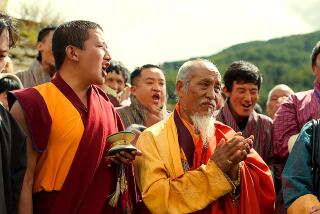‘Windhorse’ Skillfully Depicts Tibetans’ Plight Under Chinese
- Share via
Paul Wagner’s stunning and courageous “Windhorse” opens in a remote mountainvillage in western Tibet in 1979 as two girls and a boy are jumping rope. As the children Dolkar, her brother Dorjee and their cousin Pema watch, two Chinese soldiers appear and gun down their praying grandfather, who had dared to put up a poster declaring, “Chinese go back to China!” Wagner, a prizewinning documentarian making his feature debut, shot key establishing sequences inside Tibet, where many of his collaborators must remain anonymous for fear of Chinese reprisal, and finished the film in Nepal.
Eighteen years hence, the three children have taken very different paths. Pema (name withheld) has become a Buddhist nun in an isolated convent while the rest of the family has moved to Lhasa, where Dolkar (Dadon) and Dorjee (Jampa Kolsang) live with their parents and grandmother, a feisty, old lady who protests a new edict banning the display of photos of the Dalai Lama, even in private homes. Dolkar has become a beautiful and popular singing star, willing to cooperate with the Chinese bureaucracy, which aims to turn her into a kind of poster girl for the “New Tibet.”
Dolkar is excited by the prospect of becoming a star all over China and sees it as the only way she and her family can escape poverty. She has fallen in love with a kind and caring young Chinese, Duan-ping (Richard Chang), an assistant producer at the Lhasa radio and TV station, who also is eager to further her career.
Handsome and moody, Dorjee has become a hard-drinking, chain-smoking pool hall habitue, cynical and embittered by Chinese oppression yet convinced that any resistance is futile.
The trio’s lives intersect again and are disrupted when Pema rallies to the support of a fellow nun, who confesses during a police raid of the convent that she has continued to display a photo of the Dalai Lama.
Wagner, who wrote his script with his niece and co-producer Julia Elliott and her Tibetan boyfriend Thupten Tsering, who also co-directed, has the right idea about how to make an effective protest film: Frame the message in a well-developed plot with three-dimensional characters. Clearly, a commitment to revealing the dire plight of the Tibetan people under Chinese rule has fueled this project, and Wagner has pulled off the not inconsiderable feat of eliciting natural and effective portrayals from nonprofessionals acting in languages foreign to him. “Windhorse” takes its title from bits of paper, inscribed with prayers for hope and freedom, that Tibetans set aloft in the winds. The film is remarkably accomplished, virtually free of self-consciousness and awkwardness and buoyed by Tommy Hayes’ plaintive score, which incorporates traditional Tibetan music.
* Unrated. Times guidelines: complex mature themes, some scenes of savage brutality.
‘Windhorse’
Dadon: Dolkar
Jampa Kolsang: Dorjee
Name withheld: Pema
Richard Chang: Duan-ping
Lu Yu: Mr. Du
Taije Silverman: Amy
A Shadow Distribution release. Producer-director Paul Wagner. Co-director Thupten Tsering. Co-producer Julia Elliott. Screenplay by Elliott, Tsering and Wagner. Cinematographer Steven Schechter. Editors Wagner, Tony Black. Principal music Tommy Hayes. In Tibetan and Mandarin, with English subtitles. Running time: 1 hour, 37 minutes.
Exclusively at the Nuart through Thursday, 11272 Santa Monica Blvd., West Los Angeles, (310) 478-6379.
More to Read
Only good movies
Get the Indie Focus newsletter, Mark Olsen's weekly guide to the world of cinema.
You may occasionally receive promotional content from the Los Angeles Times.










